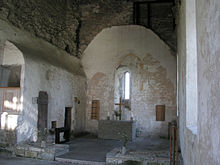Källa ödekyrka
Källa ödekyrka , also called Källa gamla kyrka , is the externally well-preserved ruin of a church in the parish of Källa on the Swedish island of Öland . The pagan spring (Källa), next to which the church was built, gave the parish its name. The name is first recorded as “ Keldo sokn ” (old Swedish “ kælda ” for source) in 1360. In the course of the construction of the previous wooden church, the spring is said to have been consecrated by Olav the saint . Originally a well in the nearby harbor was identified with the source, but in 1960 another collapsed well was discovered in the northwestern part of the cemetery. Källa is a port from which limestone was shipped.
Building history
The wooden predecessor church, which was discovered in 1971 during excavations within today's church, also had a cemetery. In addition to traces of burned wood, graves were discovered in which, according to Christian custom, burials had been carried out in an east-west direction. As the attacks and looting increased from the Baltic Sea , a stone defense tower was built in the course of the 12th century. It had five floors and was higher than the rest of it. Some floors each had two barrel vaults, which were alternately oriented in east-west and north-south directions. An entrance still preserved today is visible on the west side of the tower at a height of about seven meters. It is unclear whether there was a connection between the tower and the wooden church.
Today's church with a rectangular floor plan was built in the second half of the 12th century or at the beginning of the 13th century, with the final, straight choir being slightly narrower than the nave . The armory was added on the south side and the sacristy on the northeast corner of the nave.
The current roof covers the remains of the tower as well as the nave and the choir. Nothing has been preserved from the vaults, nor from the mezzanine and upper floors. The remnants of the vaults can still be seen as beginnings in the masonry. The loopholes on the upper floor are only visible from the inside and are covered by plaster on the outside.
Surroundings
The cemetery is surrounded by a wall made of limestone and sandstone . It is about 1.3 m wide and varies in height between 90 cm in the south and 1.3 m in the west. Two entrances have been preserved in the wall. The southern one was built around an older wooden gate in 1756. The western entrance, built in 1827, also had a wooden predecessor. Both are made of limestone and have a stepped gable . In the northeast area of the cemetery are the remains of several buildings. It is unclear whether these are the remains of a rectory. However, in the 17th century, until the fire on June 28, 1630, the rectory was west of the church.
literature
- Boström, Ragnhild: Källa gamla kyrka . In: Svenska fornminnesplatser . 3. Edition. Riksantikvarieämbetet , Stockholm, 1978.
- Boström, Ragnhild: Källa kyrkor . In Sveriges kyrkor; Öland; 128.1: 4 . Almqvist & Wiksell, Stockholm 1969.
Web links
- Sveriges kyrkor: a collaboration between Riksantikvarieämbet and Sockenkyrkoprojektet
- http://www.ekdahl.org/relative/kyrka.htm
Individual evidence
- ↑ Svenskt local dictionary . Språk- och folkminnesinstitutet (SOFI), Uppsala, 2003. p. 181. ISBN 91-7229-020-X
Coordinates: 57 ° 6 ′ 40.9 ″ N , 16 ° 59 ′ 10.8 ″ E



